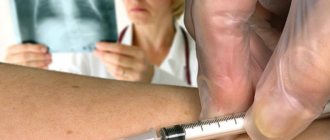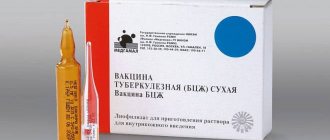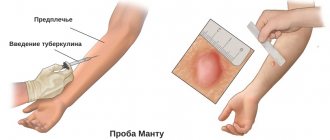The trace of Mantoux persists for 4-7 days after the administration of tuberculin, but sometimes it remains for several weeks or even a month. Such a reaction may indicate the presence of Koch's bacillus in the baby's body (the causative agent of tuberculosis) or the individual reaction of the body to manipulation.
To exclude the possibility of infection, parents should visit a TB doctor and undergo an additional examination - the child is prescribed Diaskintest, which is highly informative and reliable.
The Mantoux mark is not a reason for making a diagnosis - it is just a local reaction of the body, which in any case will be individual.
What should be the trace of Mantoux?
After performing the Mantoux test, both parents and the doctor must monitor the trace from it - its characteristics allow one to assess the likelihood of the child becoming infected with tuberculosis pathogens. There is a gradation of papule sizes:
- the size of the “button” within 0.2 cm is the absolute norm;
- a Mantoux mark of up to 0.4 cm is also considered normal, but requires additional consultation with a TB doctor;
- an increase in the “button” to a size of 5-16 mm is considered a positive reaction, the child requires a full examination by a phthisiatrician;
- a papule size of 17 mm or more indicates the presence of tuberculosis pathogens in the patient’s body and a high probability of infection.

The Mantoux mark appears almost immediately after the administration of tuberculin, but its true dimensions can only be measured on the third day after the manipulation - the data will be as reliable and informative as possible.
How long does it take?
The Mantoux papule disappears within 2-3 days after measurement (5-6 days after the test), but in some children the redness and brownish spot may remain for several weeks, up to a month. If the patient feels great, his behavior has not changed, and the tuberculin injection site is gradually healing, and there are no symptoms of inflammation or purulent process, then there is no need to worry about the long-term preservation of the mark.
Duration of development of reaction to tuberculin administration
The first Mantoux test must be taken as soon as the child turns one year old; a similar procedure is repeated every year. The test results are carefully recorded in the child’s medical record and compared with previous ones. In particular, doctors pay attention to the size of the papule and the duration of the skin reaction.

The Mantoux reaction is a unique response of the body to the introduction of tuberculin, an extract from carrier bacteria, injected into the baby’s forearm. At the injection site, the attraction of T-lymphocytes that have “acquaintance” with Koch’s bacillus begins; they accumulate under the skin, so the growth of the button begins.
After administration of the drug, you need to carefully monitor changes in the papule. An increase of up to 2 mm is normal; swelling of 2 to 4 mm is also not cause for concern, but requires additional consultation.
The growth of a button from 5 to 16 mm is a positive reaction, and should alert parents and doctors; in this case, the child is registered with a phthisiatrician for more careful monitoring. A papule that appears, having a size of 17 mm and above, in most cases indicates a large number of tuberculosis bacteria in the body and possible infection.
It is worth remembering that all changes with a button take place in the first 3 days. The body's strongest response is observed on the third day, which is why the reaction is checked at this time.
Next, the skin reaction should gradually disappear, and normally after a week and a half there should be no traces of the drug administration on the child’s hand.
The duration of the reaction may vary depending on the individual characteristics of the child’s body: sometimes the trace of Mantoux can be completely unnoticeable already on the second or third day, or can persist for more than a week.
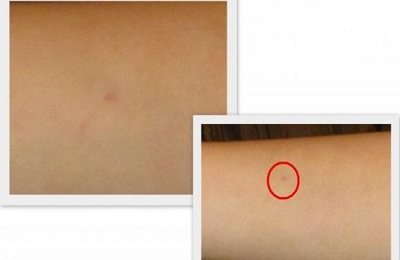
However, if nothing bothers the child and the papule itself is not inflamed, not seriously enlarged and noticeably decreases over a short time, then there is no need to worry.
A recent BCG vaccination, which is done to create immunity against tuberculosis pathogens, can also influence the duration of the reaction. The Mantoux test determines the presence of these bacteria in the body, which is expressed in a long-lasting and pronounced skin reaction.
The child himself can provoke a long-term reaction to the Mantoux test if he does not follow the rules of caution. In particular, it is strictly prohibited:
- rub the injection site with a washcloth;
- bathe in hot water, steam papules;
- squeeze out liquid from the papule;
- treat the wound with brilliant green, iodine, peroxide.
Why does the trace of Mantoux remain and take a long time to pass?
If the trace from Mantoux takes a long time to pass, then during the first month you don’t have to worry about it. The reasons for this may be:
- bathing a child in hot water;
- scratching the tuberculin injection site;
- treating papules with brilliant green, iodine, cologne or alcohol;
- increased skin sensitivity to irritation.
It is also important to take into account the time of BCG placement - if the vaccination was done shortly before Mantoux, then the mark will be red and will take a long time to fade. In addition, an allergy to the drug can also be the “culprit” for the long-lasting trace of Mantoux - it can be relieved with antihistamines, which the child can take only after consultation with a pediatrician.
If 5 days after performing the Mantoux test, the papule itches, remains red, and increases in volume, then this may indicate a violation of the manipulation technique:
- the medical worker did not properly treat the injection site with a disinfectant;
- tuberculin was stored and transported incorrectly;
- the drug was not administered intradermally, but deeper.
The reaction to the Mantoux test can persist for a long time even if it was performed without taking into account contraindications. The doctor should find out whether the child has the following conditions:
- history of an allergic reaction to any irritant;
- rheumatism;
- epilepsy, even if it is in the stage of long-term drug remission;
- bronchial asthma;
- diseases of a dermatological nature;
- acute course of colds, sore throats and any respiratory infectious diseases.
Mantoux reaction - how often to do the “button”
“The drug is intended for mass diagnosis of tuberculosis,” clarifies Alexander Ushakov. — It is used according to a set schedule. Use once a year in children over 12 months. Twice a year can be used only for clear indications in certain groups of children. These are children from social risk groups and those with chronic diseases, who, due to weakened immunity, most often develop tuberculosis. And also children who had contact with people with tuberculosis.”
The test can also be used:
- before the first BCG vaccination in babies older than two months, to exclude the possibility of infection with the tuberculosis bacillus;
- to diagnose the disease, including in the early stages, when there are no external manifestations of the disease, but the child already poses a danger to others;
- with a severe allergic reaction to Diaskintest, which does not allow the use of this diagnostic method in the patient. In this case, the Mantoux test in an adult or child becomes the only possible test for tuberculosis.
Unlike Diaskintest, which only indicates the fact of infection, Mantoux’s results are more informative. They help the doctor clarify whether the child still has immunity to tuberculosis, formed by the BCG vaccination. Over time, the level of antibodies in the body decreases, and when they become too low, a booster vaccination with BCG is carried out.
Every year, the results of the Mantoux test are measured and recorded in medical records. And every year the obtained values are compared with the previous ones. When the test does not show a result, a negative Mantoux reaction is recorded. This means that immune protection against tuberculosis is lost, and BCG vaccination must be carried out as soon as possible. And to do this, you should contact a pediatrician or phthisiatrician at a children's clinic.

pixabay.com/
What to do if there is no trace from Mantoux
If there is no trace of Mantoux for a long time, this does not mean confirmation of tuberculosis - parents should contact a phthisiatrician, undergo a full examination and only after that take any action. First of all, the specialist will find out what kind of reaction to Mantoux there was before (if the procedure has already been carried out), whether the child had contact with a patient with tuberculosis or a carrier of the pathogen, and whether there is a history of an allergic reaction to any irritant. Diaskintest is most often prescribed, which allows the doctor to:
- confirm or deny the presence of Koch's bacillus in the child's body (the causative agent of tuberculosis);
- assess the activity of the inflammatory process;
- identify an allergy to the administered drug using the Mantoux test.
The difference between the Mantoux test and Diaskintest is that in the latter case it is not tuberculin that is introduced into the child’s body, but a substance made from proteins of synthetic origin.

They do not cause allergies and allow you to absolutely accurately determine the presence or absence of the tuberculosis pathogen in the body.
If the long-term preservation of a trace from the sample is associated with an allergic reaction of the child to the administered drug, then doctors give the following recommendations:
- for 3-5 days, give the baby antihistamines - Suprastin, Tavegil, Diazolin;
- exclude hyperallergenic foods from the child’s menu, as well as “heavy” foods (fried, smoked, fatty);
- Give your baby more fluids - tea, compotes, fruit drinks, which will speed up the process of removing the allergen from the body.
Any activities can be carried out only after coordination with a pediatrician or phthisiatrician.
How long does a mantu trail last and when will it disappear?
There is reason to think
Everything is not so bad for you; in your case, the probability of getting tuberculosis is about 20%. We recommend that you take better care of your immunity, living conditions and personal hygiene, and you should also try to minimize the amount of stress.
The situation clearly requires intervention
In your case, everything is not as good as we would like. The probability of infection with Koch bacilli is about 50%. You should immediately contact a specialist when the first symptoms of tuberculosis appear! It is also better to monitor your immunity, living conditions and personal hygiene, and you should also try to minimize the amount of stress.
It's time to sound the alarm!
The probability of infection with Koch sticks in your case is about 70%! You need to consult a specialist if any unpleasant symptoms appear, such as fatigue, weak appetite, or a slight increase in body temperature, because all of these may be symptoms of tuberculosis! We also highly recommend that you undergo a lung examination and do a medical test for tuberculosis. In addition, you need to take better care of your immunity, living conditions and personal hygiene, and you should also try to minimize the amount of stress.
Task 1 of 14
Does your lifestyle involve heavy physical activity?
- Yes, daily
Sometimes
Task 2 of 14
How often do you take a tuberculosis test (eg Mantoux)?
- I don’t even remember when was the last time
- Every year, without fail
- Once every couple of years
Task 3 of 14
Do you carefully observe personal hygiene (shower, hands before eating and after walking, etc.)?
- Yes, I wash my hands all the time
- No, I don't follow this at all
- I try, but sometimes I forget
Task 4 of 14
Do you take care of your immunity?
- Yes
- No
- Only when sick
- I find it difficult to answer
Task 5 of 14
Have any of your relatives or family members had tuberculosis?
- Yes, parents
- Yes, close relatives
- No
- I can not say for sure
Task 6 of 14
Do you live or work in an unfavorable environment (gas, smoke, chemical emissions from enterprises)?
- Yes, I live permanently
- No
- Yes, I work in such conditions
- Previously lived or worked
Task 7 of 14
How often are you in damp, dusty or moldy environments?
- Constantly
- I'm not there
- Previously was
- Rarely, but it happens
Task 8 of 14
Do you often get sick with acute respiratory infections or acute respiratory viral infections?
- I'm constantly sick
- Rarely, no more than once a year
- Often, more than 2 times a year
- I never get sick or once every five years
Task 9 of 14
What kind of life do you lead?
- Sedentary
- Active, constantly on the move
- Sedentary
Task 10 of 14
Does anyone in your family smoke?
- Yes
- No
- Happens sometimes
- Used to smoke
Task 11 of 14
Do you smoke?
- Yes, I smoke regularly
- No and never smoked
- Rarely, but it happens
- Previously smoked, but quit
Task 12 of 14
How old are you?
- Under 18
- From 18 to 25
- From 25 to 40
- More than 40
- Task 13 of 14
- What gender are you?
- Task 14 of 14
- Do you often experience stress?
How many days does it take for the trail from Mantoux to pass? On average, doctors say that the trace from the Mantoux test disappears from 5 to 14 days. If after this time the situation does not improve, it is better to consult a doctor. In order for the mantoux stain to go away as quickly as possible, you need to follow the recommendations of doctors.
There can be a lot of factors why the trace of a manta ray does not go away for a long time. The most common of them is the individual characteristics of the body. For some people, the test will pass 4-5 days after the administration of the drug, at the same time, there is a category of people for whom the effect remains for the rest of their lives. If the child feels well, but the manta does not pass, it is too early to ring the bells.
In addition, the healing of the mark is greatly influenced by how long ago the child was vaccinated with BCG. After all, it is aimed at creating immunity against the bacillus, the extract from which is administered during the Mantoux test. If BCG was done very recently, the mark may acquire a bright red tint and may not go away for a long time.
Also, healing is directly affected by the saturation of the blood with protein enzymes. Children whose spots do not heal for too long may be referred to a specialist for further examination to accurately rule out the risk of disease.
It is worth noting that if the child is allergic, then the possibility of an allergy to the administered drug cannot be ruled out.
If there was a Mantoux reaction, but there is no trace
Sometimes the Mantoux test gives a positive reaction, but already on the 4th day after the administration of tuberculin there is no trace and it is even impossible to find the injection site. This “behavior” of the body means that the child does not have tuberculosis and no additional research is required. Most often, the complete absence of a trace of Mantoux indicates the child’s strong immunity, low sensitivity of the baby’s skin to irritants and the absence of allergies.
The Mantoux test in almost every case leaves a mark on the child’s hand. It can be pronounced and almost unnoticeable, persist for 1-2 weeks or not disappear for a month. In any case, a doctor must evaluate the body’s reaction to the administered tuberculin; in some cases, additional research and observation by a phthisiatrician is required.
After how many days is the Mantoux reaction checked?
The test is quite safe and does not require special preparation. It rarely causes allergies, so a child’s severe allergic status does not become a contraindication to it.
Tuberculin should not be administered to a child who exhibits:
- acute disease - infectious or skin;
- exacerbation of a chronic disease;
- allergy with severe symptoms.
Quarantine for childhood infections is another contraindication to the test. It can be carried out immediately after quarantine is lifted and the child has fully recovered. After ARVI, influenza and other viral diseases, at least four weeks must pass, as after any previous vaccination.
You should not rush to perform Mantoux and turn a blind eye to a runny nose or poor health of the child, as this affects the diagnostic result. A viral disease can provoke a “false-positive” reaction to Mantoux.
Despite the fact that the test is usually well tolerated, sometimes after it the body temperature may rise. The child may experience weakness and headache. This is a natural response to the introduction of tuberculin. Normally, these reactions are short-term and should go away within one to two days. If the child has a high temperature or the general condition has deteriorated significantly, it is necessary to immediately consult a doctor. Such a response from the body may indicate infection with the tuberculosis bacillus.
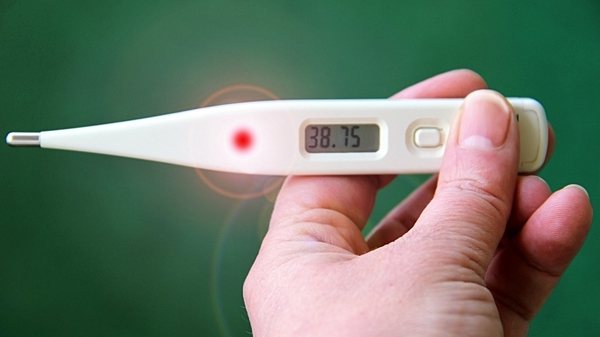
pixabay.com/
The result of the injection is assessed after 72 hours. Immediately after administration of the drug, a “button” forms under the skin, which quickly resolves. Then the injection site turns red, and an infiltrate may form - a compaction.
“You can wet the injection site,” says the pediatrician. “But in order not to provoke a false positive reaction, you should not scratch or rub this area for three days. You can’t wash it with soap or shower gel.”




